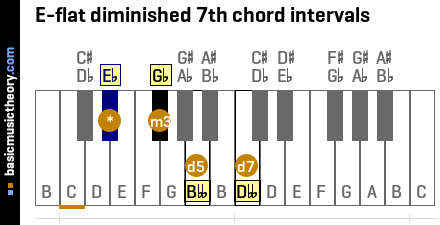Seventh chord
| Diminished 7th | C | C# | Db | D | D# | Eb | E | E# | Fb | F | F# | Gb | G | G# | Ab | A | A# | Bb | B | B# | Cb |
|---|---|---|---|---|---|---|---|---|---|---|---|---|---|---|---|---|---|---|---|---|---|
| Half-diminished 7th | C | C# | Db | D | D# | Eb | E | E# | Fb | F | F# | Gb | G | G# | Ab | A | A# | Bb | B | B# | Cb |
| Minor 7th | C | C# | Db | D | D# | Eb | E | E# | Fb | F | F# | Gb | G | G# | Ab | A | A# | Bb | B | B# | Cb |
| Minor-major 7th | C | C# | Db | D | D# | Eb | E | E# | Fb | F | F# | Gb | G | G# | Ab | A | A# | Bb | B | B# | Cb |
| Dominant 7th | C | C# | Db | D | D# | Eb | E | E# | Fb | F | F# | Gb | G | G# | Ab | A | A# | Bb | B | B# | Cb |
| Major 7th | C | C# | Db | D | D# | Eb | E | E# | Fb | F | F# | Gb | G | G# | Ab | A | A# | Bb | B | B# | Cb |
| Augmented 7th | C | C# | Db | D | D# | Eb | E | E# | Fb | F | F# | Gb | G | G# | Ab | A | A# | Bb | B | B# | Cb |
| Augmented-major 7th | C | C# | Db | D | D# | Eb | E | E# | Fb | F | F# | Gb | G | G# | Ab | A | A# | Bb | B | B# | Cb |
| Major 7th suspended 2nd | C | C# | Db | D | D# | Eb | E | E# | Fb | F | F# | Gb | G | G# | Ab | A | A# | Bb | B | B# | Cb |
| Major 7th suspended 4th | C | C# | Db | D | D# | Eb | E | E# | Fb | F | F# | Gb | G | G# | Ab | A | A# | Bb | B | B# | Cb |
| Dominant 7th suspended 4th | C | C# | Db | D | D# | Eb | E | E# | Fb | F | F# | Gb | G | G# | Ab | A | A# | Bb | B | B# | Cb |
7th chord definition and construction
Seventh chords contain 4 notes played together, or overlapping.
Like triad chords shown in Triad chord, seventh chords have different qualities as shown in the last column of the table below.
Seventh chords are built on triad chord qualities, but with an extra note, whose name is based on the 7th note of the major scale.
| Based on triad.. | 2nd note quality | 3rd note quality | 4th note quality | 7th chord quality |
|---|---|---|---|---|
| diminished | minor (m3) | diminished (d5) | diminished (d7) | diminished o |
| diminished | minor (m3) | diminished (d5) | minor (m7) | ½-diminished ø |
| minor | minor (m3) | perfect (P5) | minor (m7) | minor |
| minor | minor (m3) | perfect (P5) | major (M7) | minor-major |
| major | major (M3) | perfect (P5) | minor (m7) | dominant |
| major | major (M3) | perfect (P5) | major (M7) | major |
| augmented | major (M3) | augmented (A5) | minor (m7) | augmented + |
| augmented | major (M3) | augmented (A5) | major (M7) | aug-major + |
| suspended 2nd | major (M2) | perfect (P5) | major (M7) | major susp. 2nd |
| suspended 4th | perfect (P4) | perfect (P5) | minor (m7) | dominant susp. 4th |
| suspended 4th | perfect (P4) | perfect (P5) | major (M7) | major susp. 4th |
> An augmented chord is usually shown with a plus symbol: +
>A diminished chord is usually shown with a circle symbol without a line through it: o
>A half-diminished chord is usually shown with a circle symbol with a line through it: ø

The piano diagram above shows the Eb dim 7 chord which is the same as the triad chord shown in the triad section above, except that it has one extra note, defined using the Eb-dim-7th note interval as shown in the first row of the table above.
7th chord inversions
7th chord inversions work in the same way as triad inversions explained in Triad chord, except since there is one more note in the chord, there is one extra inversion that can be done.
Using the 7th chord above, the root position 7th chord has Eb as the first note.
For the 1st inversion, this note is moved to the end leaving note Gb as the first note.
For the 2nd inversion, Gb from the 1st inversion is moved to the end leaving note Bbb as the first note.
For the 3rd inversion, Bbb from the 2nd inversion is moved to the end leaving note Dbb as the first note.